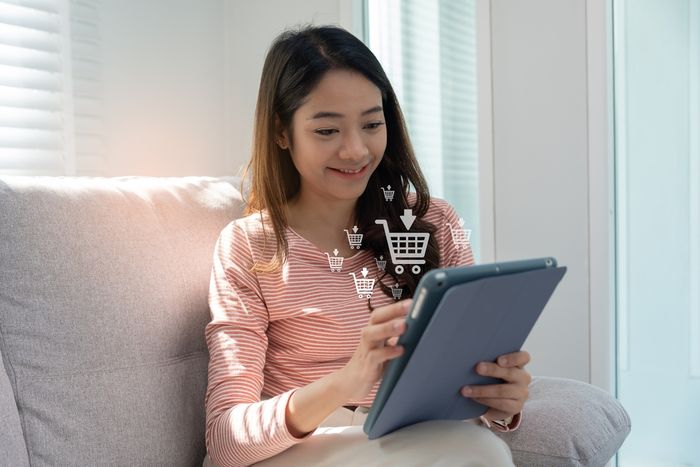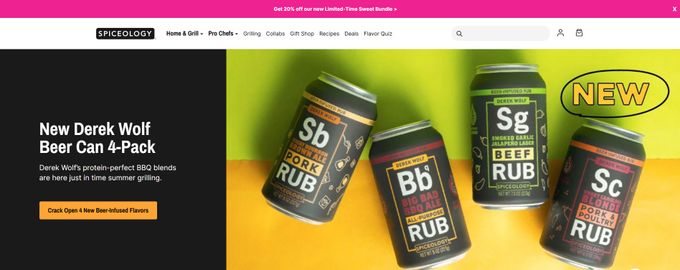Evolution of Merchandising: How Visual Appeal Drives Online Sales
Shoppers by with their eyes. That hasn't changed. But how you present your products visually has. Explore the evolution of merchandising to make sure you stay on top of changes.
Updated November 19, 2024.

Merchandising is a crucial aspect of eCommerce in today's digital age. The way you present and market your products online has a significant impact on consumer behavior and sales. Below, we take a look at the evolution of merchandising and how visual appeal helps to drive online sales.
Meet the Expert
Ashlee Colliver is an eCommerce and digital growth specialist. She is the Executive Director of Client Services at Shero Commerce, a global agency that helps develop brands from design and launch to marketing and optimization.
Early Days of eCommerce Merchandising
Initially, eCommerce merchandising strategies were basic. It mainly involved listing products on a website without much emphasis on visuals. So, consumers had a less engaging online shopping experience due to fuzzy images and a lack of categorization. However, as technology advanced and consumer expectations grew, merchandising became more important.
» Blast from the past: Explore the rich history of merchandising
Power of Captivating Imagery
One notable merchandising strategy that has stood the test of time is using captivating imagery. Just like flipping through a magazine and being drawn to a visually stunning full-page image, your online shoppers respond similarly to beautiful visuals.
Whether it's an enticing lifestyle image or an aesthetically pleasing product photo, visual merchandising creates a momentary pause and captivates consumers, enticing them to explore further.
But visual appeal goes beyond aesthetics. In physical retail spaces, packaging and product placement are crucial to attract customers. Similarly, effective online merchandising relies on well-designed websites and engaging visuals to draw users in. By strategically using colors, typography, and social proof, you can encourage your customers to complete their buying journey.
Spiceology: Adding Flavor to Product Promotions
Spiceology, a spice seller for professional chefs and home cooks, promotes a new range of beer-infused BBQ spice rub with a colorful product banner. This is offset by a black block with a product description.
Plus, the orange call-to-action button makes it very clear how the customer should proceed. Finally, a bright pink banner stands out at the top of the page to let customers know about a sale.
» Want to optimize your visual merchandising? Consider these dos and don'ts
How Personalization Influences Visuals
The evolution of eCommerce has led to personalization and automation. You can now create personalized experiences based on users' preferences and behavior, thanks to technologies like AI and machine learning, along with chatbots.
Personalization also translates to your online store's visuals. By tailoring the shopping experience to each user's interests, your store can visually adapt to individual shoppers. For example:
- Promotions on your homepage can be for products the customer regularly buys.
- Product collections can showcase relevant discounted or new products first.
- Personalized product recommendations on product pages or during checkout create good upsell and cross-sell opportunities.
A personalized approach lets you enhance your visual merchandising by aligning content with the shoppers' interests, increasing the likelihood of conversion.
Bright Minds: Shedding Light on Individual Customer Needs
Bright Minds, a children's educational online retailer, personalizes their customers' shopping experience at three points:
- Recently viewed products (browsing history)
- What others have bought (upsell and cross-sell opportunities)
- Top sellers that customers might enjoy (personalized product recommendations)
Pro tip:
Use AI Visual Discovery to let your customers search for products with images. Optimized for mobile, this integrated shopping experience can also boost your social commerce.
Balancing Personalization and Exploration
While personalization and automation enhance the overall shopping experience, it's still important to strike a balance between the benefits of personalization and the need for customers to explore. In extreme cases, customers are presented only with what they already intend to buy.
They can lose the opportunity to discover new items. The ideal middle ground is to encourage exploration and serendipitous discovery within personalized shopping experiences.
» Learn how to create the ultimate personalization experience for your shoppers by improving your site navigation
How Branding Solidifies Merchandising
Branding plays a significant role in merchandising. While some companies prioritize selling their products, others understand the power of branding and storytelling.
Branding goes hand-in-hand with visual appeal to drive online sales. Consistent and compelling branding elements, such as logos, color schemes, and imagery, create a cohesive and recognizable brand identity.
When shoppers encounter these familiar branding elements, they develop trust and loyalty, making them more likely to engage with your brand and make a purchase.
Nike: Just Doing Branding and Merchandising
Nike solidifies their branding and merchandising by focusing on the emotional connection and lifestyle associated with their products. They sell more than just clothing; they sell confidence, power, and a sense of belonging.
When shopping in their store under "Sport", the products are shown in action. In some cases, famous athletes are showing how they use Nike's products. This brings across a sense of authority because it suggests that Nike is preferred by professionals. Plus, it empowers customers and prospective athletes because they're using the same products as their favorite athletes.
» Make sure to address these eCommerce hiccups that influence brand loyalty
Mastering Visual Appeal in eCommerce Merchandising
Digital merchandising has undergone a remarkable transformation, driven by technological advancements. Visual appeal has consistently been the key to capturing the attention of shoppers, both online and offline. With the rise of personalization and automation, you can leverage captivating imagery and thoughtful branding to create a compelling online presence and drive sales.









